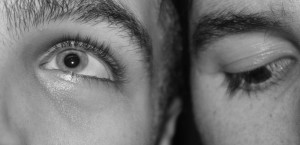Urban students say eye contact promotes relationships

I have been at this school for nearly two years and I still have not spoken to all 350 of you. We have communicated in another way. We have passed in the halls, met eyes, made the conscious decision to lock irises, and then cavalierly, or perhaps, in a state of paranoia, looked away.
Although the delicate politics of eye contact in this school are not typically discussed, their existence is downright undeniable.
When I talked to Urban students, they were well aware of this cultural phenomenon. Nico Kert (‘12) acknowledged that people look away because “they don’t feel like being honest and truthful.”
The labyrinth of hallways we occupy puts a certain pressure on students to feel close to those with whom they share the space.
I agree with Laura Rothman (‘10) that, “at Urban it feels like you need to (make things less awkward).
People at Urban really feel the need to act upon eye contact. I make eye contact, followed by a little tilt … There’s this (necessary) facade of awkward, an aesthetic awkward,” that is a part of the culture.
“Walking around, there are different kinds of contact. It feels good when it’s the right kind.”
The phenomenon has also been observed by Kaern Kreyling, school counselor, who says, “the hallway is a space to reconnect with (people) you’re already confident in, or it’s a treacherous space and there’s nowhere you’re confident- sometimes it can be intermittent. There are all kinds of journeys people have.”
Our school is large enough that we do not have to know whether such-and-such has a low tolerance for coffee, but it’s small enough to encounter the same person in the halls approximately four times on a typical Thursday. The hallways can become a surreal haze: There you are, mystery kid, coming around the corner on the second floor. Quick! What do I do?
Duncan Magidson (‘12) has an idea. “I just look 10º to my left. Not far enough to know that you’re looking in one direction, but far enough so that people don’t know … they’re not going to see you looking at them and they’re not going to see you looking away.” Being surrounded in a web of people who I only know by eye; it is sometimes overwhelming to remember how little I know.
There are times when the distance between us is not only forced, but unwanted. It is a stifling distance. We are polite, but we are also unwilling to give that nervous-looking freshman the smile he clearly deserves. We are afraid to say hello, to make that simple effort to get to know someone, when it is acceptable to just pass them by.
Our choices are powerful. “People retreat into themselves,” Kreyling says. “A lot of people don’t realize how they contribute to the problem … it’s hard to know how it’s so ingrained, this kind of deadpan face. The more sites in the community where (hallway culture) is talked about, where these ways of practicing and being are made visible,” the better off we will be. “These are revolutionary actions,” she says. And I agree. Identifying our daily polarization is our best bet for overcoming it because to recognize it means that it exists.
Where can we look, Urbanites? It all depends on how much we are willing to give. I, for one, will still be looking you straight in the eyes. You are allowed to look away.











